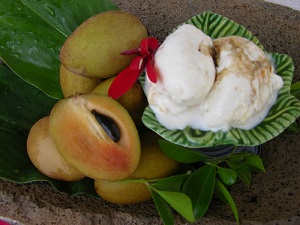From Fairchild Tropical Botanic Garden
by Noris Ledesma Curator
Sapodilla
(Chiku) as a delicate dessert
As published in the Miami Herald
A combination of peach, pear, cinnamon, honey and just a touch of
brandy best describe the alluring flavor of the sapodilla. Sapodilla
fruit are soft and sweet, with a delicate aroma hinting of the beauty
to come.
The sapodilla (Manilkara
sapota) is native to Central
America, but its unique appeal carried it centuries ago to Southeast
Asia, where it has undergone a wonderful transformation. The Maya
described it as dainty, fragrant and well tasting - a delicate fruit
indeed. Sapodilla is delicious to eat out of hand, and can also be made
into a great dessert sauce or mousse. The texture when eaten fresh
should be that of a good ripe pear. Elite selections from Asia and the
Americas can be eaten skin and all.

Sapodilla Desert
The
sapodilla was probably introduced to Florida from the Bahamas in the
1800s. The sapodilla tree is an attractive, slow-growing evergreen
tree. In Florida, trees mainly bear from May to September, but fruit
may mature throughout the year. Sapodilla trees can be grown from seed,
but may take six to 10 years to produce fruit and there is considerable
variability among seedling trees. There have been a number of new
cultivars developed in Florida, with various fruit sizes, flavors,
colors, and maturity dates.

'Makok' cultivar
‘Makok’
is long, pointed, and one of the best tasting of the sapodillas. It is
native to Thailand, and is a recent introduction to Florida. This is an
excellent variety for homeowners because the tree is a true dwarf,
forming a small and compact tree perfect for limited spaces. The fruit
should be thinned to increase fruit size. The pulp is smooth and brown
with a sweet aroma and each fruit will have a single, small seed. It
ripens from May to November.
‘Alano’
is an oval shaped fruit native to Thailand, and it is arguably the
finest sapodilla in the world. The fruit is sweet and the texture is
that of an ultra fine pear. The trees are heavy regular producers of
medium sized fruit typically weighing about nine ounces. In addition to
the fruit’s superior quality the tree tends to be less brittle
and have a much smaller habit than other cultivars. The fruit ripens
from November to June.
‘Hasya’
is a football shaped fruit native to Mexico where it is the number one
commercial cultivar grown. The fruit is of excellent eating quality and
it has a reddish hue throughout the pulp. The tree is a large upright
grower, and it is a prolific producer of large fruit that typically
weigh thirteen ounces. The fruit ripens from November to June.
‘Molix’
is another football shaped fruit native to Mexico. This fruit is
similar to Hasya in many ways, but it tends to be darker brown outside,
less red inside, and the tree has curly leaves. The pulp is
exceptionally sweet with a fine pear texture and pleasant aroma. The
fruit are large typically weighing thirteen ounces. The season differs
slightly from that of Hasya, beginning in February and ending in May.
‘Tikal’
was selected in Florida. The fruit are ovoid in shape, but are fat at
one end like a top. This variety was one of the first superior
commercial varieties planted in Florida, but its popularity has
diminished with the introduction of larger more productive cultivars.
Fruit size can vary, but they can get as large as eleven ounces. The
fruit ripen from December to March.
Where to grow
sapodilla: The
sapodilla plant grows well in a warm and sunny and preferably frost
free location. Sapodilla trees prefer well-drained, sandy soil with
regular applications of water to young trees. Once established they are
very drought- and salt- tolerant. Sapodilla trees are tolerant of windy
conditions and young trees generally do not have a problem with
establishment on windy sites if they are pruned properly.
Addition
of plant mulch to the soil surface will improve water-holding capacity,
nutrient retention and availability and soil structure. Fertilization
is best done with three applications per year (March, July and
September) of an 8-3-9 or other fruit tree formulation. Most mature
sapodilla trees receive no watering, but irrigation in dry season may
increase productivity.
Sapodilla trees respond favorably to punning
and shaping. Each year after harvest trees shoud be pruned, removing
the upright branches and keeping the tree 6 to 8 feet tall.
Harvest:
It is hard to tell when the sapodilla is ready to pick. However, the
fruit do have their own subtle indicators. By knowing the season that a
particular variety ripens, a grower can narrow the time frame down to
an eight to ten week period. The best way to determine maturity for
harvest is to scratch the skin. The color of the flesh should be a
cinnamon brown. Immature fruit will be green.
To ripen
sapodillas keep them at room temperature for 5 - 10 days. The fruit
should be eaten when still slightly firm, not mushy. Firm-ripe
sapodillas may be kept for a week in good condition in the home
refrigerator. They are best served fresh and chilled, and then they can
be halved or cut into wedges.
Sapodilla
Kulfi (Indian ice cream)
(makes about 15 Popsicle molds)
12-oz can evaporated milk
14-oz can sweetened condensed milk
1 pint heavy whipping cream
3 slices white bread soaked in milk and squeezed to remove as much
liquid as possible
2 cups sapodilla puree
1 tsp vanilla extract
20 almonds, blanched and peeled, (optional)
l ½ cup pistachios, (optional)
Blend all ingredients until smooth. Pour into Popsicle molds or
ice-cream cups and freeze.
Back to
Sapodilla Page
|
|

